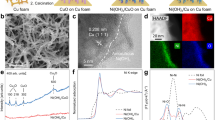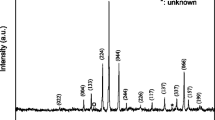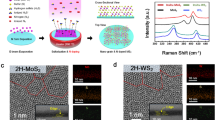Abstract
Ammonia (NH3) synthesis via electrocatalytic nitrogen reduction generally suffers from low NH3 yield and faradaic efficiency. Compared with activating stable, low-solubility N2, the electrochemical conversion of nitrates to ammonia provides a more reasonable route for NH3 production. Herein, we introduce Ar-plasma to enhance the interaction between copper-nickel alloys and carbon substrate to improve the performance of NH3 production. The NH3 faradaic efficiency from nitrate is nearly 100% and the yield rate is over 6000 \({\mathrm{\mu g}}_{{\mathrm{NH}}_{3}}{\mathrm{cm}}^{-2}{\mathrm{h}}^{-1}\). DFT (density functional theory) calculation reveals the high performance of Cu50Ni50 originates from the lower energy barrier on the reaction path and the closer position to the Fermi level of the d-band center. This work offers a promising strategy for plasma-modified electrocatalyst to promote ammonia synthesis via nitrate reduction.





Similar content being viewed by others
References
Foster, S.L., Perez-Bakovic, S.I., Duda, R.D., et al. 2018. Catalysts for nitrogen reduction to ammonia. Nature Catalysis 1: 490–500.
Lee, H.K., Koh, C.S.L., Lee, Y.H., et al. 2018. Favoring the unfavored: selective electrochemical nitrogen fixation using a reticular chemistry approach. Science Advances 4: e3208.
Shipman, M.A., and Symes, M.D. 2017. Recent progress towards the electrosynthesis of ammonia from sustainable resources. Catalysis Today 286: 57–68.
Martín, A.J., and Pérez-Ramírez, J. 2019. Heading to distributed electrocatalytic conversion of small abundant molecules into fuels, chemicals, and fertilizers. Joule 3: 2602–2621.
Zi, X., Wan, J., Yang, X., et al. 2021. Vacancy-rich 1T-MoS2 monolayer confined to MoO3 matrix: an interface-engineered hybrid for efficiently electrocatalytic conversion of nitrogen to ammonia. Applied Catalysis B: Environmental 286: 119870.
Wang, C., Gu, L.-L., Qiu, S.-Y., et al. 2021. Modulating CoFe2O4 nanocube with oxygen vacancy and carbon wrapper towards enhanced electrocatalytic nitrogen reduction to ammonia. Applied Catalysis B: Environmental 297: 120452.
Davidson, E.A., David, M.B., Galloway, J.N., et al. 2012. Excess nitrogen in the US environment: trends, risks, and solutions. Issues in Ecology 15: 1–16.
Rosca, V., Duca, M., de Groot, M.T., et al. 2009. Nitrogen cycle electrocatalysis. Chemical Reviews 109: 2209–2244.
Seraj, S., Kunal, P., Li, H., et al. 2017. PdAu alloy nanoparticle catalysts: Effective candidates for nitrite reduction in water. ACS Catalysis 7: 3268–3276.
Wang, D., He, N., Xiao, L., et al. 2021. Coupling electrocatalytic nitric oxide oxidation over carbon cloth with hydrogen evolution reaction for nitrate synthesis. Angewandte Chemie International Edition 46: 24605–24611.
Chen, J.G., Crooks, R.M., Seefeldt, L.C., et al. 2018. Beyond fossil fuel-driven nitrogen transformations. Science 360: eaar6611.
Hawtof, R., Ghosh, S., Guarr, E., et al. 2019. Catalyst-free, highly selective synthesis of ammonia from nitrogen and water by a plasma electrolytic system. Science Advances 5: eaat5778.
Singh, A.R., Rohr, B.A., Schwalbe, J.A., et al. 2017. Electrochemical ammonia synthesis-the selectivity challenge. ACS Catalysis 7: 706–709.
Dima, G.E., de Vooys, A.C.A., and Koper, M.T.M. 2003. Electrocatalytic reduction of nitrate at low concentration on coinage and transition-metal electrodes in acid solutions. Journal of Electroanalytical Chemistry 554: 15–23.
McEnaney, J.M., Blair, S.J., Nielander, A.C., et al. 2020. Electrolyte engineering for efficient electrochemical nitrate reduction to ammonia on a titanium electrode. ACS Sustainable Chemistry & Engineering. 8: 2672–2681.
Wang, Y., Aoni, X., Wang, Z., et al. 2020. Enhanced nitrate-to-ammonia activity on copper-nickel alloys via tuning of intermediate adsorption. Journal of the American Chemical Society 142: 5702–5708.
Fu, X., Zhao, X., Hu, X., et al. 2020. Alternative route for electrochemical ammonia synthesis by reduction of nitrate on copper nanosheets. Applied Materials Today 19: 100620.
Perdew, J.P., Burke, K., and Ernzerhof, M. 1996. Generalized gradient approximation made simple. Physical Review Letters 77: 3865.
Wang, V., Xu, N., Liu, J.C., et al. 2021. VASPKIT: A user-friendly interface facilitating high-throughput computing and analysis using VASP code. Computer Physics Communications. 267: 108033.
Dumitrascu, N., Topala, I., and Popa, C. 2005. Dielectric barrier discharge technique in improving the wettability and adhesion properties of polymer surfaces. IEEE Transactions on Plasma Science 33: 1710–1714.
Wu, A., Yang, J., Xu, B., et al. 2021. Direct ammonia synthesis from the air via gliding arc plasma integrated with single atom electrocatalysis. Applied Catalysis B: Environmental 299: 120667.
Niu, H., Zhang, Z., Wang, X., et al. 2021. Theoretical insights into the mechanism of selective nitrate-to-ammonia electroreduction on single-atom catalysts. Advanced Functional Materials 31: 2008533.
Nørskov, J.K., Bligaard, T., Logadottir, A., et al. 2005. Trends in the exchange current for hydrogen evolution. Journal of the Electrochemical Society 24: 23–26.
Figueiredo, M.C., Solla-Gullón, J., Vidal-Iglesias, F.J., et al. 2013. Nitrate reduction at Pt(100) single crystals and preferentially oriented nanoparticles in neutral media. Catalysis Today 202: 2–11.
Pérez-Gallent, E., Figueiredo, M.C., and Katsounaros, I. 2017. Electrocatalytic reduction of Nitrate on Copper single crystals in acidic and alkaline solutions. Electrochimica Acta 227: 77–84.
Da Cunha, M.C.P.M., de Souza, J.P.I., and Nart, F.C. 2000. Reaction pathways for reduction of nitrate ions on platinum, rhodium, and platinum-rhodium alloy electrodes. Langmuir 16: 771–777.
Acknowledgements
This work is supported by the National Natural Science Foundation of China (No. 51976191) and the State Key Laboratory of Clean Energy Utilization (No. ZJUCEU2021003), Ecological civilization project, Zhejiang University and the Fundamental Research Funds for the Central Universities.
Author information
Authors and Affiliations
Corresponding authors
Ethics declarations
Conflict of interest
The authors declare that they have no conflict of interest.
Additional information
Publisher's Note
Springer Nature remains neutral with regard to jurisdictional claims in published maps and institutional affiliations.
Rights and permissions
About this article
Cite this article
Yimeng, Z., Jiabao, L., Yaqi, P. et al. Ar-plasma enhanced copper-nickel alloy catalysis for ammonia synthesis. Waste Dispos. Sustain. Energy 4, 149–155 (2022). https://doi.org/10.1007/s42768-022-00095-2
Received:
Revised:
Accepted:
Published:
Issue Date:
DOI: https://doi.org/10.1007/s42768-022-00095-2




